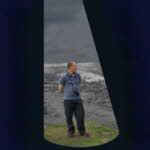1000-foot or more sheer drop, the Muse Escarpment
The work programme completed, it was now time to head homeward, myself to the club and my driver helper Mohammed to his family.
Here at the junction, I cut the engine’s reassuring purr and allowed the dust to settle.
It’s decision time and the blank area on the map is no help.
This Friday morning; to the left is a weekend driving of two or three days on a safe road, to be at the office on Monday morning. To the right, with luck, we should be home tonight, so why hesitate?
Well, this shortcut includes the Muse Escarpment; descending 2000 feet in a mile and a half.
Four years earlier, I made the trip as a passenger in the middle seat of a Land Rover, so I knew what was coming.
Fortunately for Mohammed, he didn’t know!
Retrospectively, the calculator makes this an average gradient of 1:3.96 (mostly loose dirt and rubble).
Some stages would be stepper than 1:3 ignorance was bliss!
Below is the Rukwa Valley 1 the land-locked lake was some eighty miles long by twenty miles wide.
Around it, are the breeding grounds of the Red locust (not the Egyptian locust).
The organisation formed to eradicate them called ‘International Red Locust Control’ built this road for access. No ordinary car would survive this descent; none were foolish enough to attempt it.
![[1] A bad shortcut down the Muse Escarpment! 1 Muse Escarpment: public use at own risk.](https://notmanywise.uk/wp-content/uploads/2012/02/muze-escarpment.jpg)
A glance up at the Muse Escarpment warning sign
Paused under it, into four-wheel drive and down we go.
The worst zig-zag involved a three-point turn and here soared the vultures, patient and optimistic.
“Move over Mohammed you’re obstructing reverse gear”. He did, but it would not engage: ‘clunk – thump’ but no reverse!
Foot on brake, hand on handbrake – the spare one waved at a fallen tree trunk.
He jumped out, dragged it under the front wheels, retired and pointed his prayer beads towards Mecca.
![[1] A bad shortcut down the Muse Escarpment! 2 The helpless Land Rover in front of the sheer drop at the Muse Escarpment.](https://notmanywise.uk/wp-content/uploads/2012/02/sheer-drop.jpg)
That’s my legs outside of the Land Rover.
Inside is Mr Micawber lifting the floor hoping ‘something will turn up’. Disappointing the vultures, it did!
![[1] A bad shortcut down the Muse Escarpment! 3 Vultures circling round.](https://notmanywise.uk/wp-content/uploads/2012/01/vultures.jpg)
One of two springs on the reverse position had broken off, dropped into the selector slot and blocked it.
That cleared, Mohammed pocketed his prayer beads, the vultures ascended and we descended.
Same place 1963 written by William Condry:
We were anxious to get past the hazards of the zig-zag road that drops you off this escarpment 2000 feet into the valley…
‘Birds and Wild Africa’ by William Condry. Collins 1967 Muse Escarpment.
We descended gingerly.
In places, the road clung to rock walls and hung over sheer drops.
It went round corners so sharp we had to unhitch the trailers and manhandle them round… most of us walking!”
Down in the valley, there’s no wind to clear perspiration, so the alluvial black dust sticks to the skin, but at a moderate speed, it made a smooth bump-free road surface.
Climbing out at the valley head, a cooling wind cleared the dust. I noted the sun’s position and settled down to two hours of navigation by bush bashing.
At last Mohammed’s prayer beads disappeared for the last time as we came upon a road pointing in the right direction.
It got us home that same day.
Joe’s Journal from my 1962 Tanganyika diaries.
Joe Lucas April 2008
See Joe’s next articles:
[2] African 1950s Safari introduction
[3] WW2 dogfight – Before the Safari days
References – open in new tabs:
[i] Thanks for the drawings from Cecily Marshall.
See The Rukwa Expedition 1938 “…it had first been visited by a European seventeen years before (1921). …The name Rukwa first appears on Burton and Speke’s map in 1858 and presumably, Speke heard of it when on his way to the southern end of Lake Victoria…” ↩

